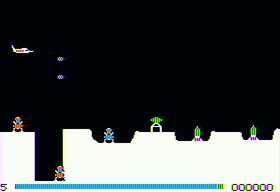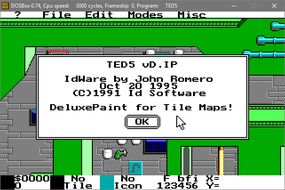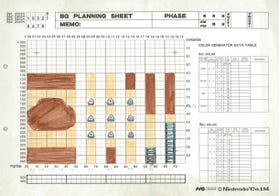Introduction
If you were to ask a room of game developers about their first experience making games, many would tell you that it involved using a tool that came with the game that they were already playing. Most likely, they found it tucked away in the same folder as the executable, sporting an enticing name like “editor.exe”.
Many years before Unity 3D, companies such as id Software, Epic, 3D Realms, Blizzard, and BioWare would release tools along with their games, in the hopes that enabling people to create new content would grow the community and extend the lifespan of the game. For many people, these tools were not only exciting to use, but they were also their gateway into the game industry. The content that they created would later become their resumes.
 In recent years, retrospectives of classic games have been well received at GDC, but there have been very few stories about classic game tools. This series of articles will attempt to fill that gap, by interviewing key people who were instrumental in the development of those classic game tools.
In recent years, retrospectives of classic games have been well received at GDC, but there have been very few stories about classic game tools. This series of articles will attempt to fill that gap, by interviewing key people who were instrumental in the development of those classic game tools.
For the first article of this series, I have the great pleasure of speaking with John Romero about TEd, the tile editor that he created at id Software, which went on to ship 33 games.
First encounter with a level editor
 DL: Hi, John. Thanks for taking the time to talk to me!
DL: Hi, John. Thanks for taking the time to talk to me!
JR: No problem!
DL: Before we talk about TEd, I want to take a step back: In the early 80s, there were very few level editors that came with the game. In your interview for the book Honoring the Code, you spoke about how the Terrain Generator in the game Pegasus ][ was one of the first level editors that you ever played with. What can you tell me about that experience?
JR: Well, the first time I saw Pegasus ][ was at Sierra College, in the Apple room. It was one of the very first things I saw on an Apple. While playing it, I saw that there was this option to do terrain generation. I thought that it was pretty cool that it has this tool built in to generate gameplay.
It’s funny to think now that this is one of the earliest games that let you generate mods. This was the first time I saw anything like this. I thought it was really cool. It's funny, I never thought "why don't other games have that?"… I just never expected it!


TEd, the Tile Editor
DL: OK, so, let's move on to talking about TEd.
[While we are talking, I launch two instances of DOSBox so we can look at TEd and Deluxe Paint, side-by-side]


The first thing I want to talk about is the TEd splash screen. It says Deluxe Paint for Tile Maps. So, anyone who has read a bit about the history of id Software knows that Adrian Carmack used Deluxe Paint…
JR: The whole industry did.
DL: Yeah! Well, one of the first things that struck me was that the menu at the top of Deluxe Paint and TEd are very similar, in terms of look and feel. Were you trying to make something that was familiar to users of Deluxe Paint, or were you re-using something that was coming from Deluxe Paint?
JR: Before id Software, I had written some tools at SoftDisk and I was writing them on PC. I wrote a program called Pixel Puzzle Maker which was a tool used to create puzzles for a Softdisk game called Pixel Puzzler. So I wrote a pull-down menu system for Pixel Puzzle maker and then I did some modifications to it. I think I created some more tools for PC at Softdisk, then when I was doing the id stuff I think I created another one, because it was pretty easy to make this pull-down menu system.
It wasn't based on Deluxe Paint, because I never used Deluxe Paint, but I just thought having a pull-down menu it was much easier compared to dealing with a whole bunch of hotkeys… even though there are a lot of hotkeys!
![]()
![]()
DL: Speaking of hotkeys, there are other similarities that I noticed. These days, we're very familiar with the Control-Z hotkey being for undo, but back then - at least in the case of Deluxe Paint and TEd - it's just the “u” key on the keyboard.
JR: [Laughs] Wow. Is that what I did?
DL: Yes! Here, if I fill in a few squares and press "u", it goes back...
[I draw some tiles, and then press “u” to undo the last action]
JR: [Laughs] Nice.
Oh, by the way, you're using DOSBox, and when you scroll around the screen, that is super slow compared to how fast it actually was on a 386 back in the day. It was lightning fast.
"EGA Scrolling using Latch mode was so fast back then, you had to tap the keys quickly because it was just flying by."
DL: Oh yeah? No kidding?
JR: DOSBox is slowing it way down for some reason. EGA Scrolling using Latch mode was so fast back then, you had to tap the keys because it was just flying by. So, you're getting to see a weird super chuggy slow version.
[Author’s note: Here is John as “user42604” on StackExchange explaining EGA Scrolling using Latch mode: http://gamedev.stackexchange.com/questions/6488/how-did-they-make-the-screen-move-in-dangerous-dave]
DL: OK, so, we were saying that TEd has a lot of hotkeys. At the time that TEd was being used, you often had to read the help file to figure out how to use tools like these.
JR: Oh yeah, definitely, and I think some people were still at the tail-end of WordStar, which was like a nightmare of hotkeys.
DL: [Laughs]
JR: Back then, we were playing Ultima, and in Ultima, every letter on the keyboard was used, so it was not difficult to remember what things did when you were used to that, back then.


[Author's Note: I dug up the manual for Ultima 1, and John is absolutely right... almost every key on the keyboard was mapped to an action!]
DL: For sure! So, when it comes to designing a level at that time in the games industry, you might use a piece of graph paper to decide where the tiles would go, and then you would type them in one at a time.
JR: Yeah.


[Author's Note: After our interview, John sent me this graph paper drawing for a game he created called Mach Six. Also, click here to see an article on Gamasutra about how Nintendo used graph paper to design levels for the original Zelda on NES]
DL: So, at which point was it decided at id Software that it was necessary to create TEd?
JR: When I created Dangerous Dave in 1988, I needed to create levels for it, and I decided "well, why don't I just use the game itself, and just let my own game create levels, and save them out". So, that's what I did with Dangerous Dave.
So, when John Carmack saw that - because he was an Apple II guy - he was really impressed, because he was used to just using text to represent graphics. When we were first starting to make stuff together, I made TEd 1.0, and it evolved over the next six months to be TEd 5.0, which was used for 33 shipped games.


DL






































